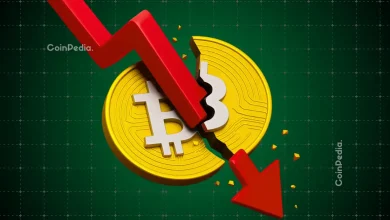
Crypto market cap drops 2.4% to $3.78T as Bitcoin and Ethereum slide, with altcoins facing steeper losses.
Fed’s hawkish stance, $631M liquidations, and Trump tariffs fuel bearish sentiment across global crypto markets.
The cryptocurrency market saw a sharp dip in the last 24 hours, with the global crypto market cap falling by over 2.4% to $3.78 trillion. Top cryptocurrencies like Bitcoin and Ethereum were not spared from the downturn. Bitcoin dropped by more than 2% and is currently trading around $115,957, while Ethereum slipped over 3.6% to $3,717.
Altcoins have taken an even harder hit. Solana (SOL) is down by nearly 4.8%, now priced at $171, while Cardano (ADA) and Dogecoin (DOGE) fell by 4.89% and 5.87% respectively. XRP also saw a drop of around 3.7%. The current sideways action across many tokens has pushed the Altcoin Season Index down to 37 out of 100, meaning that Bitcoin continues to dominate market attention.
Why Are Cryptos Falling Today?
This downturn has been largely triggered by macroeconomic uncertainty, particularly after the U.S. Federal Reserve decided to keep interest rates unchanged while issuing a stern warning about slowing economic growth. Markets had briefly rallied after the White House released a crypto policy report pushing for clearer SEC guidelines, but that faded quickly as the Fed’s message began to sink in.
Adding to the pressure, total liquidations across the crypto market reached nearly $631.98 million. When global economic signals turn bearish, capital tends to move out of riskier assets like altcoins first. With crypto no longer operating in a vacuum, market sentiment is being shaped by the same global forces that drive equities and commodities.
As of August 1st, President Donald Trump’s aggressive tariff strategy is beginning to take effect. While tariffs are traditionally a concern for traditional markets and international trade, their ripple effect is now increasingly being felt in crypto markets. Tariffs often trigger inflationary pressures and destabilize fiat currencies, conditions that sometimes push investors toward Bitcoin and other digital assets as a hedge. However, in the short term, these sudden shocks often lead to liquidity crunches and panic selling, especially in risk-on assets like altcoins.
Never Miss a Beat in the Crypto World!
Stay ahead with breaking news, expert analysis, and real-time updates on the latest trends in Bitcoin, altcoins, DeFi, NFTs, and more.
FAQs
Crypto markets fell 2.4% due to Fed holding rates, economic warnings, and $632M liquidations. Bitcoin dropped to $115,957 (-2%), Ethereum to $3,717 (-3.6%).
Yes – Fed’s unchanged rates + growth warnings triggered selloff. Crypto now reacts to macro trends like stocks, with $631M liquidations.
Yes – typical risk-off move after Fed news. Bitcoin (-2%) held better than altcoins (-3-6%), showing relative stability during pullbacks.
Recovery likely after macro uncertainty clears – watch for Fed policy shifts (Sept meeting) and ETF inflows. Historically bounces within 2-4 weeks after similar dips.
Trust with CoinPedia:
CoinPedia has been delivering accurate and timely cryptocurrency and blockchain updates since 2017. All content is created by our expert panel of analysts and journalists, following strict Editorial Guidelines based on E-E-A-T (Experience, Expertise, Authoritativeness, Trustworthiness). Every article is fact-checked against reputable sources to ensure accuracy, transparency, and reliability. Our review policy guarantees unbiased evaluations when recommending exchanges, platforms, or tools. We strive to provide timely updates about everything crypto & blockchain, right from startups to industry majors.
Investment Disclaimer:
All opinions and insights shared represent the author's own views on current market conditions. Please do your own research before making investment decisions. Neither the writer nor the publication assumes responsibility for your financial choices.
Sponsored and Advertisements:
Sponsored content and affiliate links may appear on our site. Advertisements are marked clearly, and our editorial content remains entirely independent from our ad partners.

![XRP News [LIVE] Update](https://image.coinpedia.org/wp-content/uploads/2025/12/01124853/How-High-or-Low-Can-XRP-Price-Go-After-Fifth-ETF-Launch-Today-390x220.webp)





